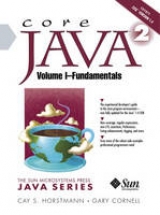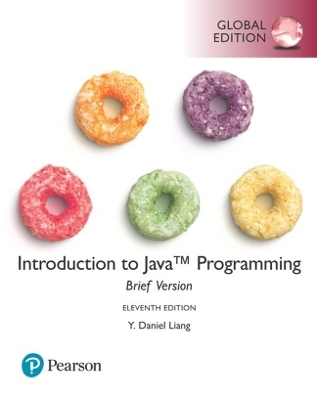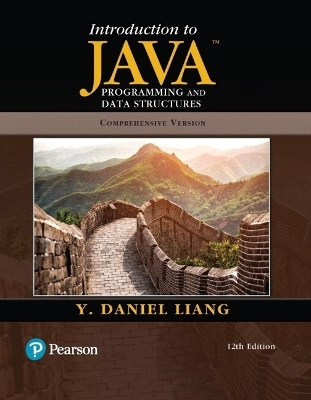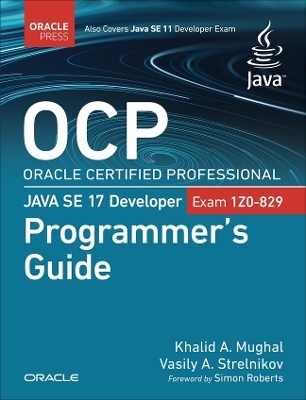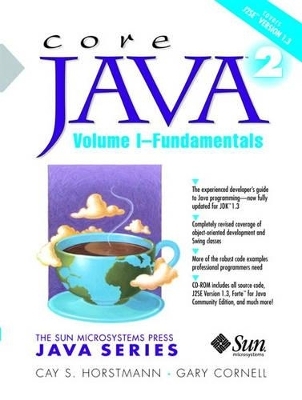
Core Java™ 2, Volume I--Fundamentals
Prentice Hall
978-0-13-089468-7 (ISBN)
- Titel erscheint in neuer Auflage
- Artikel merken
This best-selling, classic Java book is now completely revised and updated to cover Java 2 and SDK 1.3 features and functions.
Ask any experienced Java programmer: Core Java delivers the real-world guidance you need to accomplish even the most challenging tasks. That's why it's been an international best seller for five straight years. Now thoroughly updated to cover Sun's brand-new JDK 1.3, Core Java 2, Volume 1: Fundamentals offers revamped discussions of object-oriented Java development, JDK 1.3's enhanced Swing user interface components, and much more. It delivers even more of the robust programs previous editions are famous for -- updated wherever appropriate to reflect JDK 1.3's deployment and performance enhancements, and to utilize improved Swing classes. It includes thorough explanations of JDK 1.3 dynamic proxy classes; inner classes; exception handling; debugging; the current Java event model; Input/Output; file management; and much more. The CD-ROM contains complete source code examples, the JDK 1.3, and a large library of valuable software, including Forte for Java, Community Edition.
CAY S. HORSTMANN teaches computer science at San Jose State University. He has written six books on C++, Java, and object-oriented development and is the series editor for Prentice Hall PTR's best-selling Core Series. GARY CORNELL has a Ph.D. from Brown University and has been a visiting scientist at IBM Watson Labs. He has written or co-written 20 popular computer books and articles for many developer magazines. He currently directs the program in Modern Visual Programming at the University of Connecticut.
1. An Introduction to Java.
Java as a Programming Tool. Advantages of Java. The Java “White Paper” Buzzwords. Simple. Object Oriented. Distributed. Robust. Secure. Architecture Neutral. Portable. Interpreted. High Performance. Multithreaded. Dynamic. Java and the Internet. Applets at Work. Server-side Java. A Short History of Java. Common Misconceptions About Java.
2.The Java Programming Environment.
Installing the Java Software Development Kit. Setting the Execution Path. Installing the Library Source and Documentation. Installing the Core Java Program Examples. Navigating the Java Directories. Development Environments. Using the Command Line Tools. Troubleshooting Hints. Using an Integrated Development Environment. Locating Compilation Errors. Compiling and Running Programs from a Text Editor. Graphical Applications. Applets.
3. Fundamental Programming Structures in Java.
A Simple Java Program. Comments. Data Types. Integers. Floating-Point Types. The Character Type. The boolean Type. Variables. Assignments and Initializations. Constants. Operators. Increment and Decrement Operators. Relational and boolean Operators. Bitwise Operators. Mathematical Functions and Constants. Conversions Between Numeric Types. Casts. Parentheses and Operator Hierarchy. Strings. Concatenation. Substrings. String Editing. Testing Strings for Equality. Reading the On-line API Documentation. Reading Input. Formatting Output. Control Flow. Block Scope. Conditional Statements. Indeterminate Loops. Determinate Loops. Multiple Selections-the switch Statement. Breaking Control Flow. Big Numbers. Arrays. Array Initializers and Anonymous Arrays. Copying Arrays. Command Line Parameters. Sorting an Array. Multidimensional Arrays. Ragged Arrays.
4. Objects and Classes.
Introduction to Object-Oriented Programming. The Vocabulary of OOP. Objects. Relationships Between Classes. Contrasting OOP with Traditional Procedural Programming Techniques. Using Existing Classes. Objects and Object Variables. The Gregorian Calendar Class of the Java Library. Building Your Own Classes. An Employee Class. Using Multiple Source Files. Analyzing the Employee Class. First Steps with Constructors. The Methods of the Employee Class. Method Access to Private Data. Private Methods. Final Instance Fields. Static Fields and Methods. Static Fields. Constants. Static Methods. Factory Methods. The main Method. Method Parameters. Object Construction. Overloading. Default Field Initialization. Default Constructors. Explicit Field Initialization. Parameter Names. Calling Another Constructor. Initialization Blocks. Object Destruction and the finalize Method. Packages. Using Packages. Documentation Comments. How to Insert Comments. Class Comments. Method Comments. Field Comments. General Comments. Package and Overview Comments. How to Extract Comments. Class Design Hints.
5. Inheritance.
Extending Classes. Inheritance Hierarchies. Polymorphism. Dynamic Binding. Preventing Inheritance: Final Classes and Methods. Casting. Abstract Classes. Protected Access. Object: The Cosmic Superclass. The equals and toString methods. Generic Programming. Array Lists. Object Wrappers. The Class Class. Reflection. Using Reflection to Analyze the Capabilities of Classes. Using Reflection to Analyze Objects at Run Time. Using Reflection to Write Generic Array Code. Method Pointers! Design Hints for Inheritance.
6. Interfaces and Inner Classes.
Interfaces. Properties of Interfaces. Interfaces and Abstract Classes. Interfaces and Callbacks. Object Cloning. Inner Classes. Using an Inner Class to Access Object State. Special Syntax Rules for Inner Classes. Are Inner Classes Useful? Are They Actually Necessary? Are They Secure? Local Inner Classes. Static Inner Classes. Proxies. Properties of Proxy Classes.
7. Graphics Programming.
Introduction to Swing. Creating a Frame. Frame Positioning. Displaying Information in a Panel. 2D Shapes. Colors. Filling Shapes. Text and Fonts. Images.
8. Event Handling.
Basics of Event Handling. Example: Handling a button click. Selecting Event Listeners. Example: Changing the Look and Feel. Example: Capturing Window Events. The AWT Event Hierarchy. Semantic and Low-Level Events in the AWT. Event Handling Summary. Low-Level Events. Focus Events. Keyboard Events. Consuming Events. Mouse Events. Actions. Multicasting. The Event Queue. Adding Custom Events.
9. User Interface Components With Swing.
The Model-View-Controller Design Pattern. A Model-View-Controller Analysis of Swing Buttons. An Introduction to Layout Management. Border Layout. Panels. Text Input. Text Fields. Input Validation. Password Fields. Text Areas. Labels and Labeling Components. Selecting Text. Editing Text. Making Choices. Check Boxes. Radio Buttons. Borders. Combo Boxes. Sliders. Menus. Building Menus. Icons in Menu Items. Check Box and Radio Button Menu Items. Pop-up Menus. Keyboard Mnemonics and Accelerators. Enabling and Disabling Menu Items. Tool Bars. Tool Tips. Sophisticated Layout Management. Grid Layout. Box Layout. Grid Bag Layout. The gridx, gridy, gridwidth, and gridheight Parameters. Weight Fields. The fill and anchor Parameters. Padding. An Alternative Method to Specify the gridx, gridy, gridwidth, and gridheight Parameters. Using No Layout Manager. Custom Layout Managers. Traversal Order. Dialog Boxes. Option Dialogs. Creating Dialogs. Data Exchange. File Dialogs. Color Choosers.
10. Applets.
Applet Basics. A Simple Applet. Running the Applet Viewer. Viewing an Applet in a Browser. Converting Applications to Applets. Life Cycle of an Applet. Security Basics. Pop-Up Windows in Applets. The Applet HTML Tags and Attributes. Applet Attributes for Positioning. Applet Attributes for Code. Applet Attributes for Java-Challenged Viewers. The OBJECT Tag. Java Plug-In Tags. Passing Information to Applets. Multimedia. URLs. Obtaining Multimedia Files. The Applet Context. Inter-Applet Communication. Displaying Items in the Browser. A Bookmark Applet. It's an Applet. It's an Application. It's Both! JAR Files. The Manifest. Jar Caching. Self-Running JAR files. Resources. Optional Packages. Sealing.
11. Exceptions and Debugging.
Dealing with Errors. The Classification of Exceptions. Advertising the Exceptions That a Method Throws. How to Throw an Exception. Creating Exception Classes. Catching Exceptions. Catching Multiple Exceptions. Rethrowing Exceptions. A Final Look at Java Error- and Exception-Handling. Some Tips on Using Exceptions. Debugging Techniques. Useful Tricks for Debugging. Assertions. Using a Console Window. Tracing AWT Events. The AWT Robot. Profiling. Coverage Testing. Using a Debugger. The JDB Debugger. The Forte Debugger.
12. Streams and Files.
Streams. Reading and Writing Bytes. The Complete Stream Zoo. Layering Stream Filters. Data Streams. Random-Access File Streams. ZIP File Streams. Putting Streams to Use. Writing Delimited Output. String Tokenizers and Delimited Text. Reading Delimited Input. Random-Access Streams. Object Streams. Storing Objects of Variable Type. Object Serialization File Format. The Problem of Saving Object References. Output Format for Object References. Security. Versioning. Using Serialization for Cloning. File Management.
Appendix.
Index.
| Erscheint lt. Verlag | 10.1.2001 |
|---|---|
| Verlagsort | Upper Saddle River |
| Sprache | englisch |
| Maße | 178 x 234 mm |
| Gewicht | 1605 g |
| Themenwelt | Informatik ► Programmiersprachen / -werkzeuge ► Java |
| Mathematik / Informatik ► Informatik ► Web / Internet | |
| ISBN-10 | 0-13-089468-0 / 0130894680 |
| ISBN-13 | 978-0-13-089468-7 / 9780130894687 |
| Zustand | Neuware |
| Haben Sie eine Frage zum Produkt? |
aus dem Bereich
